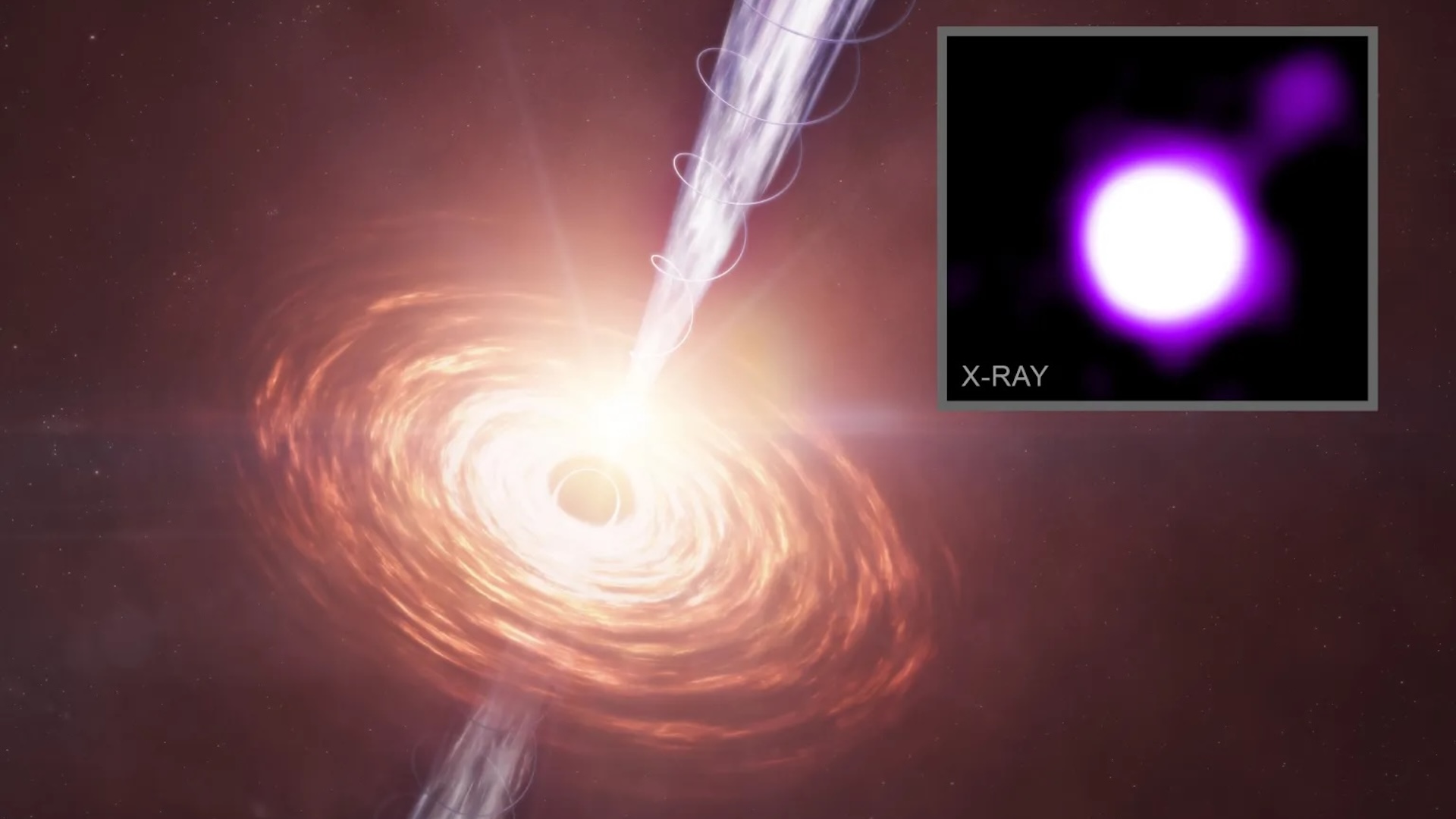Astronomers have captured a ghostly image of an ancient supermassive black hole shooting a giant energy jet into the early universe. The ethereal structure is only visible thanks to the “afterglow” of the Big Bang and a crucial NASA space telescope that could soon be prematurely switched off forever.
The striking image shows the light of quasar J1610+1811, shining from around 11.6 billion light-years from Earth, during the “cosmic noon” — a period of the universe between 2 billion and 3 billion years after the Big Bang. Quasars are supermassive black holes that shoot out giant, lightsaber-like beams of energy perpendicular to their swirling accretion disks. However, until now, researchers have not had a proper look at J1610+1811’s energy jet, despite discovering the object back in 2018.
The new image was captured with NASA’s Chandra X-ray Observatory, which is fine-tuned to hunt some of the most powerful wavelengths of the electromagnetic spectrum. The research was uploaded to the preprint server arXiv on April 13 and has been accepted for future publication in The Astrophysical Journal. The researchers also presented their findings at the 246th meeting of the American Astronomical Society, held between June 8 and 12 in Anchorage, Alaska.
Using the new image as a guideline, the team calculated that the quasar’s jet is more than 300,000 light-years long, which is around three times wider than the Milky Way. High-energy particles within the jet are also likely shooting from the black hole at between 92% and 98% the speed of light.
“The jet from J1610+1811 is remarkably powerful, carrying roughly half as much energy as the intense light from hot gas orbiting the black hole,” which is among the fastest and hottest matter in the universe, NASA representatives wrote in a statement.
Related: Behold the first direct image of a supermassive black hole spewing a jet of particles
Despite their immense power, jets like J1610+1811’s are hard to detect because they are often pointed away from Earth, which makes them appear much dimmer thanks to special relativity. However, Chandra could see this jet because it is “being illuminated by the leftover glow from the Big Bang itself,” NASA representatives wrote. This afterglow is the cosmic microwave background (CMB), leftover radiation from just after the cosmos-birthing explosion that permeates the entire universe.
During cosmic noon, the CMB was much more dense than the version we can currently detect from Earth, which is what creates the static heard on radios and seen on old televisions. As electrons from the black hole’s jets shoot toward Earth, they collide with photons within the CMB and accelerate these light particles to become X-rays, which can be spotted by Chandra.
Without the high density of the CMB during this period, the quasar would not have shone in X-ray light and the image would not have been possible.
During the study, the researchers captured less-detailed images of another quasar, J1405+0415, which is also shining at us from the cosmic noon. The new findings could help shed light on why quasars and other supermassive black holes grew faster and larger during this period than at any other point in the universe’s history.
X-ray “extinction”
Chandra was launched in July 1999 and has since revolutionized X-ray astronomy. Today, it is still making new discoveries, including a fracture in a “cosmic bone” and never-before-seen types of pulsars.
However, despite having an estimated 10 years of operational lifespan remaining, the space telescope’s future is in doubt, due to some NASA funding problems in 2024 and the Trump administration’s proposed budget cuts for 2026, which would be the largest in the agency’s history. If the latest cuts are approved, Chandra will likely be switched off permanently.
The loss of Chandra would be equivalent to an “extinction-level event” for X-ray astronomy in the United States, according to the website SaveChandra.org.
“I’m horrified by the prospect of Chandra being shut down prematurely,” Andrew Fabian, an X-ray astronomer at the University of Cambridge, told Science magazine in 2024.
“If you start doing deep cuts so abruptly, you will lose a whole generation [of X-ray astronomers],” Elisa Costantini, an astronomer at the Netherlands Institute for Space Research, added in an interview with Science. It will leave “a hole in our knowledge” of high-energy astrophysics, she said.
